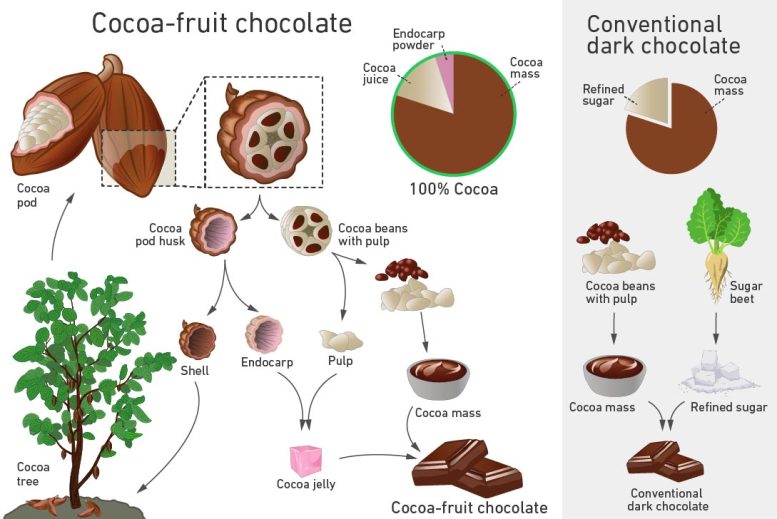
ETH Zurich’s new cocoa-fruit chocolate maximizes the use of the whole cocoa fruit, increasing its health benefits by boosting fiber and reducing saturated fat content. This innovation not only promises a healthier indulgence but also improves sustainability and farmer incomes by utilizing more components of the cocoa fruit.
New cocoa-fruit chocolate boosts health, sustainability, and farmer incomes by fully utilizing the cocoa-fruit.
- ETH researchers have developed a type of chocolate that is more sustainable and nutritious than conventional varieties.
- Cocoa-fruit chocolate uses cocoa fruit jelly as a replacement for powdered sugar, reducing the sugar content and increasing the product’s nutritional value.
- This new chocolate recipe also has the potential to diversify the income sources of small farmers.
The primary components of chocolate are cocoa mass and cocoa butter, both of which are derived from the cocoa fruit. However, there are many other useful ingredients in the cocoa fruit that are largely underutilized in traditional chocolate recipes.
In a new Innosuisse project, researchers from ETH Zurich are collaborating with sustainability-focused chocolate start-up Koa, and Swiss chocolate manufacturer Felchlin to create a new chocolate recipe that maximizes the use of the whole cocoa plant. This new recipe is healthier, more sustainable, and increases the profitability of cocoa cultivation.
Crafting the Perfect Chocolate Recipe
The cocoa fruit is very similar to the honeydew melon. “These fruits have similar structures. Both have a hard outer shell that reveals the flesh of the fruit when cut open, as well as the cocoa beans or melon seeds and pulp in the interior,” explains Kim Mishra, lead author of the team’s Nature Food publication. While traditional chocolate production uses only the beans, the new cocoa-fruit chocolate recipe incorporates the fruit’s flesh and parts of its shell—the endocarp—into a powder mixed with pulp to create a cocoa gel. This gel, which is naturally very sweet, serves as an excellent substitute for the powdered sugar typically added to chocolate.
However, perfecting this recipe was challenging. The researchers had to balance the texture and sweetness of the chocolate carefully, ultimately determining that up to 20 percent of the cocoa gel could be used without creating a clumpy texture. The experiments showed that chocolate may contain up to 20 percent gel, which equates to the sweetness of chocolate with 5 to 10 percent powdered sugar. In comparison, conventional dark chocolate can easily contain between 30 and 40 percent powdered sugar.
Sensory Testing and Health Benefits
To test the sensory experience of the new recipes, trained panelists from the Bern University of Applied Sciences taste-tested pieces of chocolate weighing 5 grams each, with some containing various amounts of powdered sugar and others containing the new variety sweetened with cocoa gel. “This allowed us to empirically determine the sweetness of our recipe as expressed in the equivalent amount of powdered sugar,” says Mishra.
Chocolate made with cocoa gel as a sweetener has more fiber and less fat than standard dark chocolate made with powdered sugar. It has 15 grams of fiber per 100 grams, while average chocolate only has 12. Additionally, cocoa-gel chocolate only contains 23 grams of saturated fat, whereas standard dark chocolate contains 33.
“Fibre is valuable from a physiological perspective because it naturally regulates intestinal activity and prevents blood sugar levels from rising too rapidly when consuming chocolate. Saturated fat can also pose a health risk when too much is consumed. There’s a relationship between increased consumption of saturated fats and increased risk of cardiovascular diseases,” explains Mishra.
Economic and Sustainable Impacts
Small-scale farmers can diversify their product offerings and increase their income if other components of the cocoa fruit can be marketed for chocolate production instead of just the beans. If most of the fruit can be used to produce cocoa-fruit chocolate, only the shell remains, which is traditionally used as fuel or composting material. “This means that farmers can not only sell the beans, but also dry out the juice from the pulp and the endocarp, grind it into powder, and sell that as well,” said Mishra. “This would allow them to generate income from three value-creation streams. And more value creation for the cocoa fruit makes it more sustainable.”
Future Directions
However, cocoa-fruit chocolate will not be hitting grocery store shelves anytime soon. “Although we’ve shown that our chocolate is attractive and has a comparable sensory experience to normal chocolate, the entire value creation chain will need to be adapted, starting with the cocoa farmers, who will require drying facilities,” says Mi

Researchers working on cocoa-fruit chocolate in a development lab at Felchlin – pictured during the Covid pandemic. Credit: Kim Mishra
shra. “Cocoa-fruit chocolate can only be produced and sold on a large scale by chocolate producers once enough powder is produced by food processing companies.” The first step has been taken: ETH has filed a patent for its cocoa-fruit chocolate recipe. The development of cocoa-fruit chocolate is a promising example of how technology, nutrition, eco-compatibility, and income diversification for small farmers can all work in tandem to improve the entire value-creation chain of the cocoa plant.
Reference: “Valorization of cocoa pod side streams improves nutritional and sustainability aspects of chocolate” by Kim Mishra, Ashley Green, Johannes Burkard, Irina Gubler, Roberta Borradori, Lucas Kohler, Johannes Meuli, Ursina Krähenmann, Jotam Bergfreund, Armin Siegrist, Maria Schnyder, Alexander Mathys, Peter Fischer and Erich J. Windhab, 21 May 2024, Nature Food.
DOI: 10.1038/s43016-024-00967-2










“However, cocoa-fruit chocolate will not be hitting grocery store shelves anytime soon. ”
——–
I’m so tired of reading similar statements on so many products featured here! How about a new rule? No reporting on anything that isn’t set to arrive in the marketplace within say, 6-9 months?
Thank you very much for the information you provided about cocoa. Is coffee consumption good for muscle cells?
When climbing a small mountain on the Fijian island of Ovalau 40 years ago, a young Fijian guide asked if we wanted ‘a drink of cocoa’ whereupon he shinned up a tree to pick a ripe cocoa pod which he broke open on a rock. We scooped out the sweet pulp and competed in how far we could spit the seeds.